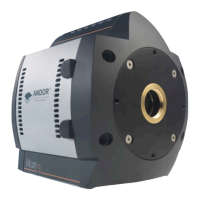Page 55
Features & Functionality
3.8 - OptAcquire
OptAcquireisauniquecontrolinterface,wherebyausercanconvenientlychoosefromapre-determinedlistofset-
up congurations, each designed to optimise the camera for different experimental acquisition types, thus removing
complexity from the extremely adaptable control architecture of the iXon3. The control architecture of the iXon3 is
extremely tuneable, meaning the camera can be adapted and optimized for a wide variety of quantitative experimental
requirements, ranging from fast single photon counting through to slower scan, 16-bit dynamic range measurements.
However, successfully optimizing EMCCD technology is not a trivial exercise, with various set-up parameters directly
inuencingdifferentcameraperformancecharacteristics.
OptAcquire,hasbeendesignedasauniqueinterfacewherebyausercanchoosefromapre-determinedlistofnine
cameraset-upcongurations.Avarietyofset-upparametersarebalancedbehindthescenesthroughtheOptAquire
menu.Furthermore,advancedusersmaywishtocreatetheirownadditionalOptAcquire.iXon3controlparameters
include:
• EM Gain – This parameter has a direct bearing on both sensitivity and dynamic range.
• Vertical clock speed–exibilityinthisparameteriscriticaltooptimizingthecameraforlowestnoise,fastest
speed, minimal frame transfer smear or maximum pixel well depth.
• Vertical Clock Amplitude – Can be employed to help ‘over-clock’ the sensor to achieve faster frame rates
and can also be used to reduce charge leakage into the image area when there is saturated signal in the frame
transfer storage area (e.g. when combining very short exposure with a slow readout speed)
• Horizontal readout speed – Ranging between 10 MHz and 1MHz. 10MHz for faster frame rates, 1 MHz for
best dynamic range.
• Pre-amplier gain – Trading off reduced digitization noise versus accessing full pixel well depth.
• EM / Conventional amplier – To choose between ultrasensitive EMCCD operation or traditional high dynamic
range CCD operation, the latter recommended for relatively ‘brighter’ signals or when it is possible to apply long
exposurestoovercomereadnoiseoor.
• Frame Transfer (overlap)–Overlappedreadoutisusedtoachieve100%dutycycle,idealforfastestframe
rate measurements without switching exposure time between frames. This mode should be deselected for time-
lapse experiments.

